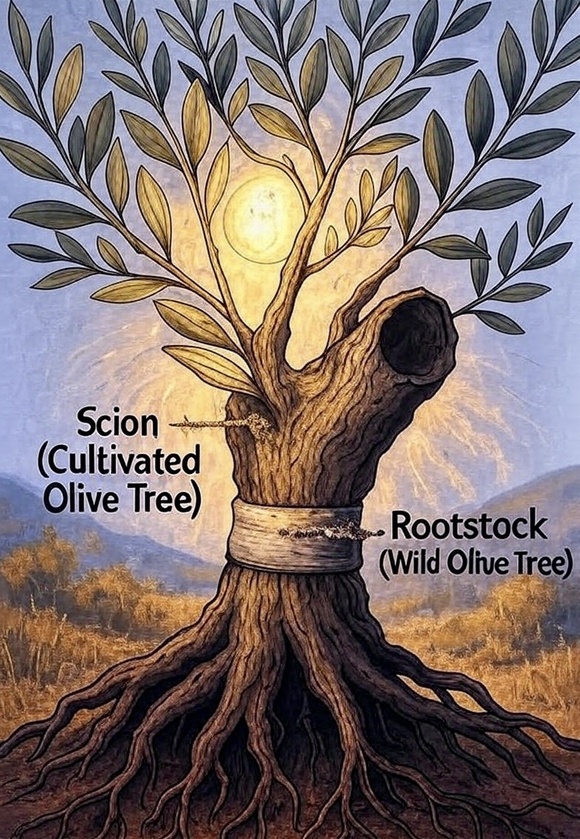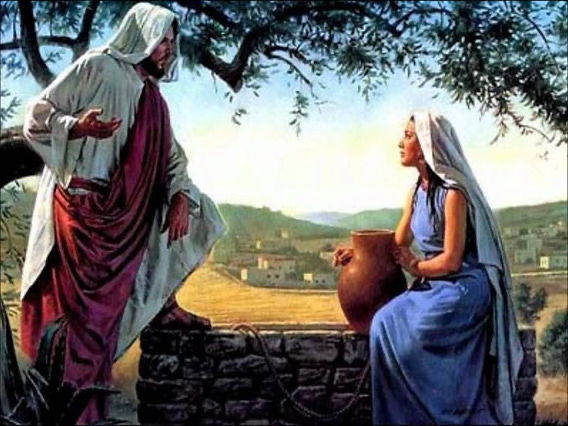Grafted In by Grace: The Call to Persevere in Faith
Romans 11:17-24
"But if some of the branches were broken off, and you, although a wild olive shoot, were grafted in among the others and now share in the nourishing root of [richness] the olive tree, do not be arrogant toward the branches. If you are, remember it is not you who support the root, but the root that supports you. Then you will say, "Branches were broken off so that I might be grafted in." That is true. They were broken off because of their unbelief, but you stand fast through faith. So do not become proud, but fear. For if God did not spare the natural branches, neither will he spare you. Note then the kindness and the severity of God: severity toward those who have fallen, but God's kindness to you, provided you continue in his kindness. Otherwise you too will be cut off. And even they, if they do not continue in their unbelief, will be grafted in, for God has the power to graft them in again. For if you were cut from what is by nature a wild olive tree, and grafted, contrary to nature, into a cultivated olive tree, how much more will these, the natural branches, be grafted back into their own olive tree."
What do you know about grafting trees?
Well it happens to be part of my industry. And there are aspects of that process that make this passage more interesting. For instance, the first thing that comes to my mind is the apostle Paul is discussing the "nature" of the wild and cultivated Olive trees. This is important because one grafts for the purpose of gaining a certain nature [characteristic] from the new scion. Something in its "nature" is desirable and so we graft it in and it becomes part of the tree. Now it's also notable that this grafting doesn't change that Scion's nature, for if it did, what would be the point.
What happens is the Root merges its cellular structure with that of the Scion's at the graft. Their cambium layers of xylem and phloem merge there and begin forming a pathway for water and nutrients to flow. So, the Root supports the Scion branch as Paul says, but the branch remains the branch.
Now this isn't to say that the character of the Scion isn't also benefiting from the character of the rootstock, no not at all. In fact, the rootstock is also selected specifically for its immutable characteristics. Often the rootstock is more hardy, has more adventitious rooting qualities. It's more qualified to be a root. And furthermore, very often if one were to set the scion on its own "wild" root, it would be very difficult to have it thrive. The Scion most definitely gains a huge advantage from the better root characteristics of the Rootstock. Its robust root system can access deeper water and nutrient sources, providing stability and sustenance that the Scion might not achieve on its own. These particular rootstocks often exhibit superior adventitious rooting, meaning they can form roots more readily from cuttings or in response to environmental stresses. This enhances their ability to anchor the plant and absorb nutrients efficiently, which is critical for the scion’s survival.
As for the Scion, these cultivated varieties are often bred for fruit quality rather than root vigor, making them dependent on a hardy rootstock to thrive. So, although the Scion contributes desirable traits (high-quality olives or oil), the rootstock provides the foundation for the Scion’s success. The graft creates a symbiotic relationship where the scion’s productivity is enhanced by the rootstock’s resilience, and the rootstock’s resources are utilized to produce valuable fruit through the Scion.
This symbiotic relationship underscores the theological unity in Romans 11. Gentile Christians gain spiritual vitality from God’s covenant with Israel, while their inclusion fulfills God’s purpose of expanding His kingdom, bringing new "fruit" to His people. Israel's God-given ability to form better roots more readily ensures a strong foundation, paralleling the enduring faithfulness of God’s promises that sustain all believers.
The Challenges of Grafting and the Risk of Failure:
Grafting is delicate. Misaligned cambium layers caused by a poor cut, poor binding, or environmental stressors (rotting disease, drought) can cause graft failure, where the Scion dies or is rejected. This aligns with Paul’s warning:
Romans 11:22
"Provided you continue in his kindness. Otherwise you too will be cut off".
Believers must remain in faith to stay connected to the nourishing root, just as a scion requires proper care to integrate with the rootstock.
Now, let's pause here:
This hits on a key point, especially for the OSAS crowd. What are the theological implications of Paul’s metaphor, particularly as it relates to the "Once Saved, Always Saved" (OSAS) debate?
Grafting is a very precise and vulnerable process. For a graft to succeed, several conditions must be met, and failure can occur due to various factors. The cambium layers of cells must align perfectly between the Scion and Rootstock for vascular tissues to fuse. In Paul's spiritual metaphor, this alignment represents the believer’s faith and connection to God’s covenant. If faith is not maintained (akin to a misaligned graft) the believer risks being disconnected from the source of spiritual life. After aligning the Scion and Rootstock, they must be tightly bound (with grafting tape) to ensure proper contact and encourage perfect fusion. Loose or inadequate binding can disrupt the graft union, leading to failure. Sometimes you'll achieve connective tissues but only partially, and the remainder of the cut begins rotting. Something hasn't fused, something hasn't be integrated together. Without this perfect binding effort, the connection weakens, increasing the risk of being "cut off." But the cut off is natural. It breaks off eventually under its own weight due to the weak connection.
And so, we understand that In Paul’s metaphor, and the cambium alignment at the graft represents the believer’s faith, which connects them to the "nourishing root" of God’s covenant (often interpreted as the promises to the patriarchs, like Abraham). Faith is the vital link that allows spiritual life to flow from God to the believer. If faith is not maintained (akin to a misaligned graft) the believer risks being disconnected from the source of life due to its misaligned faith. This suggests that salvation requires ongoing faith, challenging the OSAS view that a one-time profession of faith guarantees eternal security regardless of subsequent belief or behavior.
Keep in mind what we learned, a weakly bound scion may initially seem connected but eventually breaks off under its own weight due to the incomplete union. The binding process symbolizes the believer’s ongoing commitment to God through faith, obedience, and relationship, "continue in his kindness" (Romans 11:22). Partial or faltering commitment (akin to loose binding or incomplete fusion) can lead to spiritual rot, where the connection weakens over time.
Spiritually, rot could represent sin, doubt, or worldly influences that erode a believer’s faith, weakening their connection to God. Environmental stressors might include trials, temptations, or persecution, which test the believer’s perseverance. Paul's conditional language undermines the OSAS assertion that salvation is irrevocable, as it suggests that believers must actively resist spiritual "rot" and endure challenges to remain grafted in. Which by the way, aligns with Jesus' teachings in Matthew chapter twenty five for instance.
Jesus’ parables in chapter twenty five reinforce the need for active faith, preparedness, and perseverance, aligning with Paul’s warning in Romans 11:22. For instance, ten virgins await the bridegroom, but only five are prepared with enough oil for their lamps. The unprepared virgins are excluded from the wedding feast when the bridegroom arrives, and he declares,
Matthew 25:12
"I do not know you".
The oil [often interpreted as The Holy Spirit] represents readiness and active faith, akin to the tight binding and proper alignment needed for a graft to succeed. The unprepared virgins, despite initially being part of the waiting group, are "cut off" from the feast due to their lack of preparation. This parallels Paul’s warning that believers must "continue in his kindness" to avoid being cut off. The parable challenges OSAS by showing that initial inclusion (being among the virgins) does not guarantee final acceptance; ongoing preparedness is required. The virgins’ exclusion suggests that salvation requires active maintenance of faith, not just an initial commitment. A one-time decision without ongoing vigilance (like a loosely bound scion) can lead to rejection.
In the Parable of the Talents, the talents represent the responsibilities and opportunities given to believers within God’s covenant. The faithful servants actively use their gifts, maintaining their connection to the master’s purpose (Rootstock), like a well-bound Scion producing fruit. The unfaithful servant, by neglecting his talent, fails to engage with the master’s mission, akin to a scion that does not fully fuse with the rootstock and succumbs to rot. The condemnation of the unfaithful servant suggests that salvation involves active stewardship, not passive assurance. But OSAS proponents might argue that the servant was never truly saved, but the parable implies he was entrusted with the master’s resources, suggesting initial inclusion. If God predestined that servant and gifted him with resources, and he failed to bear fruit, what can we say but he is cut off. His failure to act results in rejection, supporting the view that salvation can be forfeited.
The Parable of the Talents and Romans 11 suggest that predestination and human responsibility coexist. While God initiates salvation (like grafting a Scion onto the Rootstock) and entrusts believers with opportunities (talents), the believer’s response determines the outcome. The unfaithful servant’s inclusion in the master’s household and receipt of a talent imply that he was chosen for service, yet his failure to act leads to rejection. Similarly, in Romans 11, the Gentiles are grafted in by God’s grace, but their continuation depends on faith (Romans 11:20-22). This challenges the OSAS view that predestination guarantees perseverance, as both texts emphasize the believer’s responsibility to respond faithfully.
Let's see if we can circle back and conclude something from all of this.
In grafting, the Rootstock (God’s covenant) provides the foundation, but the Scion must integrate properly to survive. Rot or incomplete fusion (lack of faith) can cause a scion to break off under its own weight, which illustrates that even a divinely initiated graft (predestined salvation) can fail if the Scion (believer) does not maintain the connection through faith and action. This suggests that predestination does not negate the need for perseverance, countering the OSAS claim that God’s sovereign choice ensures eternal security.
And it's important to note God's sovereign plan at this point. The grafting process, with its inherent vulnerability, (requiring perfect alignment, tight binding, and protection from rot), highlights the believer’s responsibility to maintain faith. God set that up, not mankind. So, the virgins’ need for oil and the servants’ stewardship of talents emphasize active participation in God’s covenant design. Even if predestined, as with the unfaithful servant, believers must respond faithfully to remain connected.
Connection. Connection. Hmmm 🤔
The Spirit empowers believers to maintain their faith, like the tight binding that ensures a graft’s success. Without the Spirit’s presence, (through neglect or quenching 1 Thessalonians 5:19), the believer’s connection weakens, leading to spiritual rot or disconnection. This again challenges OSAS by showing that salvation involves ongoing reliance on the Spirit, not just an initial experience.
But maybe it is as simple as they were never truly saved. Not really born-again.
1 John 2:19
"They went out from us, but they were not of us."
While John 10:28 and Romans 8:38-39 suggest that God's sovereign power will prevail against all these things, Romans 11:22 and Matthew 25 emphasize that believers can choose to disconnect through unbelief or neglect. External forces may not separate them, but their own actions can. Some argue that God’s predestination guarantees perseverance (Philippians 1:6). Yet, the unfaithful servant’s failure, despite being chosen and entrusted, and Paul’s conditional warning suggest that our human response is critical. And it's notable that in the grafting analogy, it's suggested that falling away can result from gradual disconnection, not just dramatic apostasy.
So, this question about predestination highlights the balance of God’s sovereignty and our human responsibility, as even those chosen must respond faithfully to remain grafted in. So, the predestination aspect is really more about God's perspective than it is about our assurance.
Philippians 1:6
"He who began a good work in you will carry it on to completion"
This reflects God’s sovereign plan to bring believers to glory. And what follows in Romans 11 is probably going to dig even deeper into that mystery, so today we won't make a definitive judgement about predestined believers. Let's let God's Spirit shed light on these things with meditation and time to reflect.
Prayer:
Heavenly Father, we thank You for Your boundless grace that grafts us into Your covenant through faith, nourishing us with the life-giving root of Your promises. Empower us by Your Holy Spirit to remain tightly bound to You, steadfast in faith, and fruitful in Your service. Guard us against spiritual rot and the weight of neglect, that we may continue in Your kindness and avoid disconnection. Illuminate our hearts with Your truth as we meditate on Your Word, trusting in Your sovereign plan while embracing our responsibility to walk faithfully with You. In Jesus’ Holy name, Amen.




















